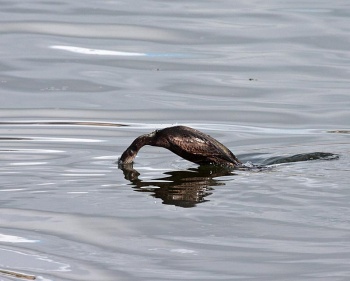Alternative names: Common Cormorant; Common Shag; Green Cormorant; Green Shag; Shag
- Gulosus aristotelis
Phalacrocorax aristotelis
Identification
68-78cm (26¾-30¾ in).
- Black plumage with metallic green sheen
- Yellow throat patch
- Small crest when breeding
- Long tail
Similar Species
Great Cormorant forehead is less steep.
Juvenile/immature Shags both have a white throat. Cormorant always have dark feet and young Shags have paler feet (webs between the toes).
Distribution
Confined to the Western Palearctic, the Shag breeds in western Iceland and the Faroes, coastal Arctic Russia to southern Norway, around north and west coasts of the British Isles, north-west France and northern Iberia. In the Mediterranean breeds in coastal Spain and the Balearics, Corsica and Sardinia, the eastern Adriatic, Crete and the Aegean and Cyprus. In North Africa breeds in coastal Tunisia and on the Atlantic coast of Morocco, possibly also on the Mediterranean coast of Egypt.
After breeding, some disperse short distances particularly young birds but many populations appear to be largely sedentary.
Recorded as a vagrant east to Poland and Finland, in Central Europe in the Czech Republic, Austria and Switzerland and as far south as the Canary Islands and Madeira, Israel and Egypt.
Taxonomy
Formerly included in the genus Phalacrocorax
Subspecies
There are 3 subspecies[1]:
- G. a. aristotelis:
- Iceland and northern Scandinavia south to Iberian Peninsula
- G. a. desmarestii:
- Mediterranean coasts and islands
- G. a. riggenbachi:
- West coast of Morocco (Casablanca to Puerto Cansado)
Habitat
Almost exclusively marine, the Shag occasionally appears on inland waters after severe weather at sea. Breeds along rocky coastlines and islands with cliffs, birds remaining in shallow coastal seas off similar coasts in winter. Rarely appears on sandy or muddy shores.
Behaviour
Flight
They are inclined to fly closer to the water than Great Cormorant, with faster wing beats. May be in lines, or loose flocks.
Diet
They dive for their food, feeding from the bottom of the sea. A variety of fish is taken, but particularly the sand eel.
Breeding
It breeds on coasts. The nests are built from seaweed and twigs and are placed on rock ledges, caves or crevices; 3 egge are laid. The young fledge after 8 weeks.
Vocalisation
References
- Clements, J. F., T. S. Schulenberg, M. J. Iliff, D. Roberson, T. A. Fredericks, B. L. Sullivan, and C. L. Wood. 2018. The eBird/Clements checklist of birds of the world: v2018. Downloaded from http://www.birds.cornell.edu/clementschecklist/download/
- Collins Field Guide 5th Edition ISBN 0 00 219900 9
- BF Member observations
Recommended Citation
- BirdForum Opus contributors. (2025) European Shag. In: BirdForum, the forum for wild birds and birding. Retrieved 16 May 2025 from https://www.birdforum.net/opus/European_Shag
External Links
GSearch checked for 2020 platform.1







